Early Computer at HP


The best web site, by far, about "The Prehistoric Times" of computers in the Hewlett-Packard company is by Steve Leibson. Steve, gives us an incredibly stylish insight into HP's early computers and the pioneers who developed them.
Steve, has done me the great honour of writing the introduction for the first chapter of the HP Memory Project dedicated to the beginning of the computer business at HP.
HP and the Computer Business
"Bill Hewlett and Dave Packard started their company in 1939 as an oscillator manufacturer. They quickly turned the company into a thriving instrumentation business, which it remained for roughly two decades. During that time, HP started selling a lot of test and measurement equipment into government research projects and that equipment generated a lot of data. Initially, all that data had to be written down by hand. Eventually, HP started selling instruments with BCD (binary-coded-decimal) output ports that could drive printers so that data recording, at least, became more automated.
But it was obvious from the start that automated data recording and processing would become a good business and HP’s internally funded spinoff Dynac (later Dymec) felt the need first because its charter was to develop and sell measurement systems based on HP instrumentation. At first, Dymec developed some simple equipment additions to ease the integration of HP instrumentation products into test and measurement systems. Dymec’s first production product was the DY-2500, a “Computing Digital Indicator,” to ease such integration.
By 1964, Dymec was experimenting with early PDP minicomputers from Digital Equipment Corporation (DEC) of Marlborough, Massachusetts. DEC’s pioneering minicomputers smashed the price barrier on computing equipment and made the idea of computer-based instrumentation systems feasible (although such systems had already existed for a decade using earlier small computer systems such as Librascope’s LGP-30).
Dymec’s investigations proved to be enough impetus for David Packard to go shopping for a computer company. He talked with Ken Olson at DEC and the two failed to come to an agreement. Then he found a 5-person company in Detroit named Data Systems, Inc. (DSI) that was owned by Union Carbide. DSI wasn’t working out for Union Carbide and Packard wanted to buy the company, but hard-headed Bill Hewlett pointed out that the minicomputer market was already flooded with competitors. Hewlett saw no reason to get into those waters because they were already shark-infested.
Finally, Packard got his way by reframing the purchase as an entree into the “instrumentation control” business. Of course, Hewlett-Packard had already been in the instrumentation business for 25 years, so grafting on a line of instrumentation controllers made perfect sense. (Note: Reframing the same product using a new name and a different context is called marketing, and it even works on hard-headed, technically-oriented managers like Bill Hewlett.)
HP bought DSI in 1964. HP Labs took over DSI’s minicomputer design, folded Dymec’s instrumentation-control ideas into the mix, and produced the HP 2116A instrumentation computer in 1966. Unlike other minicomputer companies, HP regarded the 2116A as just another instrument and made the machine pass all the same environmental tests that it used to qualify the company’s test and measurement equipment. As a result, the HP 2116A was a rugged, go-anywhere sort of computer and was not a hot-house flower that required a temperature-controlled room like many of its rivals.
The HP 2116A and its successors had a very long and successful life. Although there was indeed a market for instrumentation computers, there was a much bigger market for reliable, business-oriented machines. HP’s 16-bit 2116A architecture filled the needs of this market quite well. Because of this machine, HP became a strong entrant in the 1960s data-processing arena and the company remains a leader in the information technology market to this day.
Steve Leibson
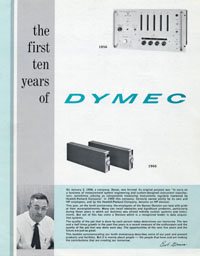 |
The Dymec Company is frequently quoted in the Steve Leibson's introduction above. The first ten years activity of this HP’s internally funded spin-off is accurately described in the original document linked below.
Its reading gives a lot of insight into the way followed by Hewlett Packard to make its entry into the computer age.

 |
HP 2116 Computer - From the Hewlett Packard Journal, March 1967 |
Short-form specifications from the 1967 catalog are the following:
General purpose digital computer with I/O system and modular software organized for on-line instrumentation systems.
Human Interface: Modified TELETYPE model ASR-33.
Progam loading: Front panel toggle switches or tape punch reader. Software (punched tape furnished):
Speed performance:
Add 3.2µs, Subtract 4.8µs, Multiply 150µs, Divide 200µs, Floating point Add 700µs, Floating point Subtract 700µs, Floating point Multiply 900µs, Floating point Divide 1.1ms.
Build in 1966 the mechanical design is very similar to instruments of this era. It was an "Instrumentation Computer", build by instrument designers to help the manufacturing of instruments. One of its major contributions was its ability to work at ambient temperature in normal lab and industry environments, without special wiring, sub flooring or other special installation preparation. Most competitors needed water-cooling at that time.
The memory technology of this period was the magnetic core. The 2116A came standard with 4096-word memory, expandable to 8192-word (and up to 16384-word with the accessory memory extender). The 2116B came standard with 8192-word memory, expandable to 32768-word with the external extender.
Depending on the configuration up to 66 electronic cards in the mainframe could draw up to 1600 Watts on the 4.5 Volts power supply. The power supply distribution is made up of one square cm, square section copper bar (shown on picture 9, below). The 2116 can drive 16 instruments in its standard configuration. Each instrument needs its own interface card in the computer mainframe. The HP-IB, single bus, multi-instruments interface would be available only 8 years later.
Move Mouse Cursor inside picture to pause
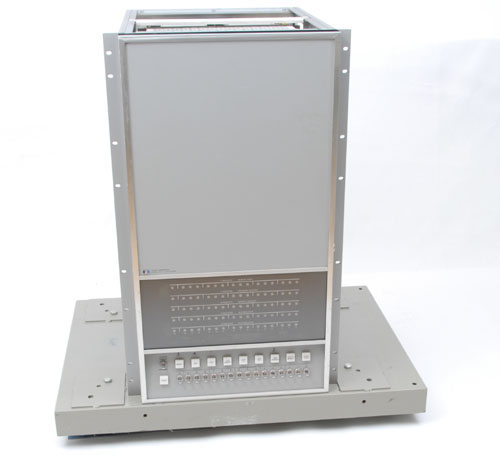
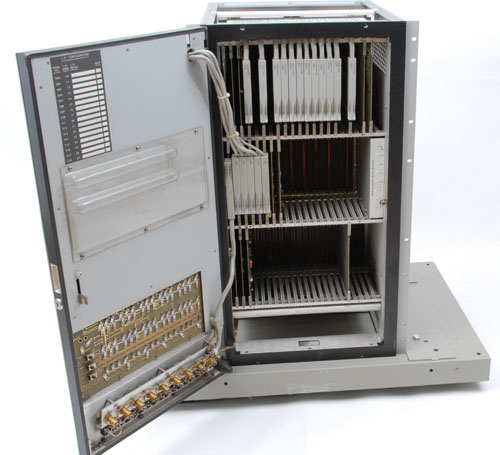
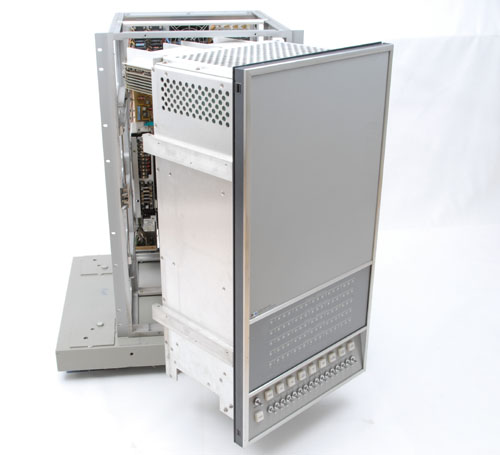
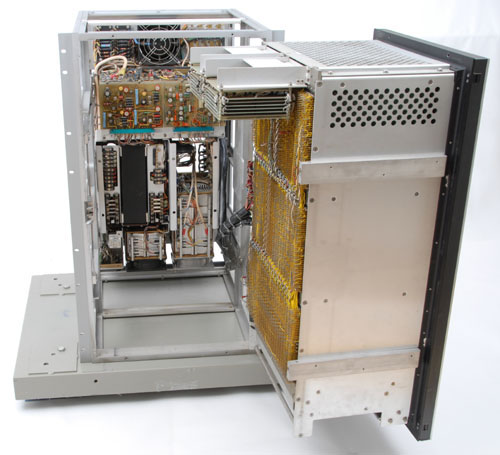
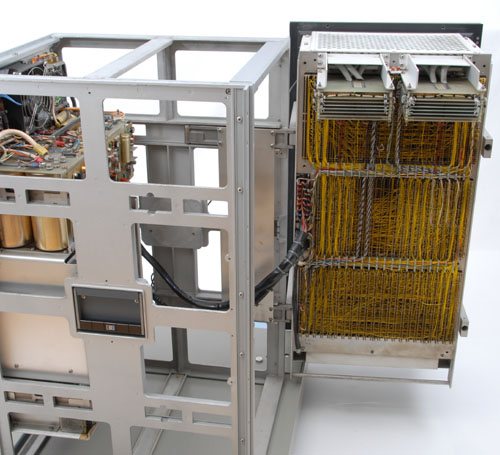

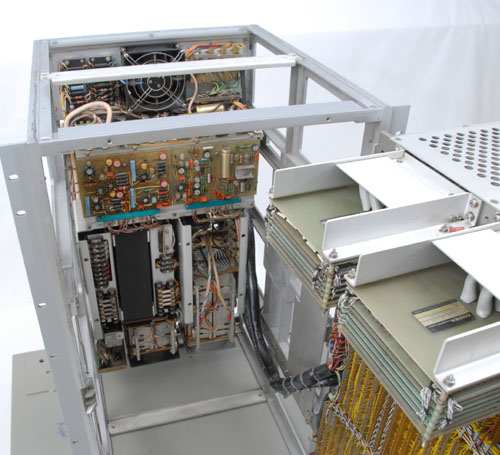
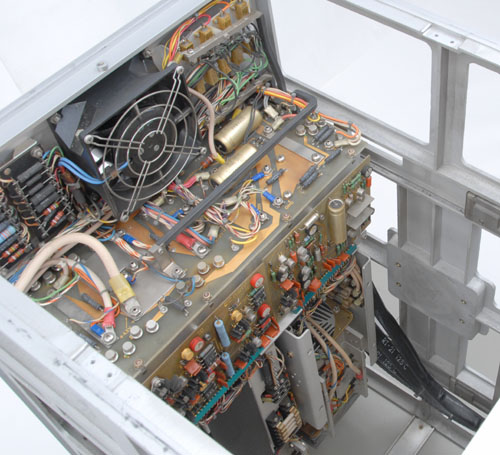
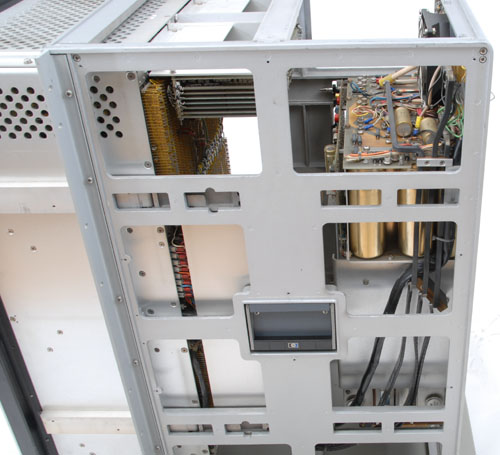
First, Introduce the best, then adapt to the market needs. This was frequent practice in the Hewlett Packard instrumentation business. The first attempts at entering the computer business didn't escape the rule . The HP 2116's Immediate successors were lower performance, lower cost computers, directly derived from the 2116 concept but built to widen the customer market .
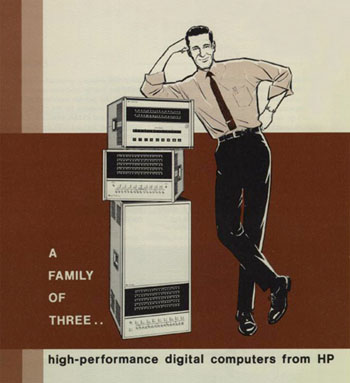 |
Cover of a 1968 Sales Brochure Courtesy of the Hewlett Packard Company |
The 2115A was introduced in 1967. The success of the HP2116A generated a large demand in general data processing. Computers used in general processing environments were not required to talk to instruments, thus eliminating the need for an I/O card cage for the 2116A and lowering the power supply requirements. The 2115A had a very short life. Although it was on HP's price list for almost five years, it was not much in demand after the 1968 introduction of the 2114A and as a result 2115 computers are very rare today.
The 2114A, introduced in 1968, was an even more economical version of the 2116A, which came standard with 4096-word or 8192-word of magnetic core memory.
The 2114 can be considered as the first HP computer directly targeting mainstream data processing applications, even if HP was still referring to its computers as "instrument controller" until the introduction of the first HP3000.
Anyway, the documents discussed in the next chapter clearly illustrate that most of the early HP computer business was dedicated to the industrial data acquisition and processing.
A good source of information about the kind of business covered by HP's early computer production is the 135 series of Application Notes. Most of these ANs were printed in the early 70s, four to six years after the birth of the 2116 . They are examples of various real-life installations designed and provided by HP to solve measurement and control problems found in a wide variety of industries.
They perfectly illustrate the way followed by Hewlett Packard to make its entry into the computer age.
Click Here to access the AN-135 listing and files in PDF format.
Another contribution to the accuracy of the story . Steve Leibson recently recorded two fabulous video interviews with Dave Cochran and Tom Osborne. These are must-see TV if you enjoy learning about the history of technology.
VIDEO |
 |
"How HP Got its First Calculators" - |

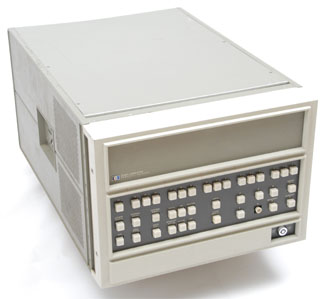 |
The HP 2100 Computer |
The HP 2100A computer was introduced in 1971. It was the industry's first microprogrammable minicomputer.
Above all it was the last HP computer claiming to be just an "Instrumentation Controller"
After the 2100A, computers at HP would be split into three different product lines. 1- The desktop calculator already existed in 1971 with the 9100A/B which would soon be updated by the second generation: 9810-20-30, to become the natural way of exchanging data with instruments in the whole industry. 2- The HP1000, a real time minicomputer would succeed the 21XX series as the controller in large system automation. 3- And finally, in 1973, with the introduction of the HP 3000, Bill Hewlett himself was obliged to admit that HP was now producing "Multipurpose Computer Systems." But not yet "Business Computers."
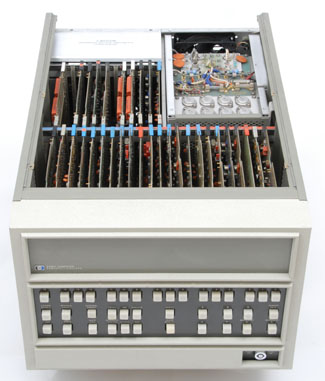 |
HP 2100A Top Inside View |
The HP 2100A computer was introduced with these features:
Like the 211X computers that it superceded, the 2100A used magnetic core memory. It came standard with 4K words of memory, upgradable within the mainframe to 32K words.
The 2100A took advantage of the last step in miniaturization of magnetic core memory. The animation below was built-up from photos of a 64 kbits memory card of the 2100A computer from the collection . Two layers out of four on the card were opened to show the layout of the core memory.
As shown in pictures 3, 4 & 5, each layer is made-up of 16 rectangular areas. Each area size is 13 x 33 mm and contains 1024 magnetic toroid cores.
A number of links could be referenced for an in-depth description of the Core Memory theory of operation. One of the best can be found on the David G Hicks, Museum of HP Calculator, web site, under the chapter: HP 9100 Technology and Packaging
Move Mouse Cursor inside picture to pause
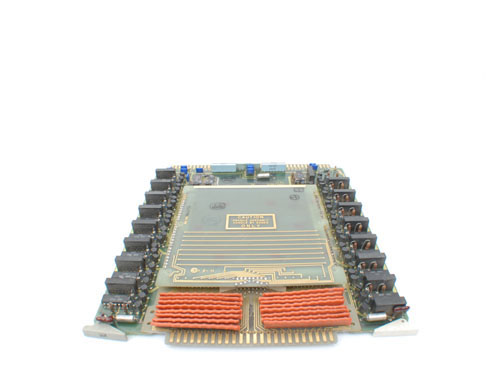
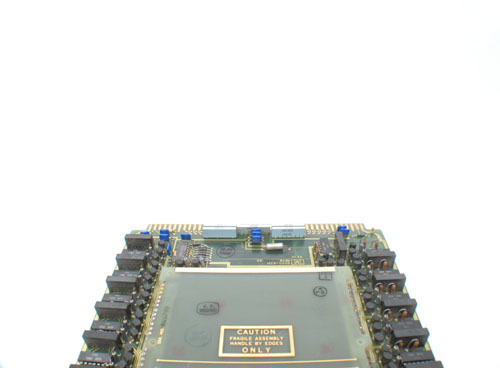
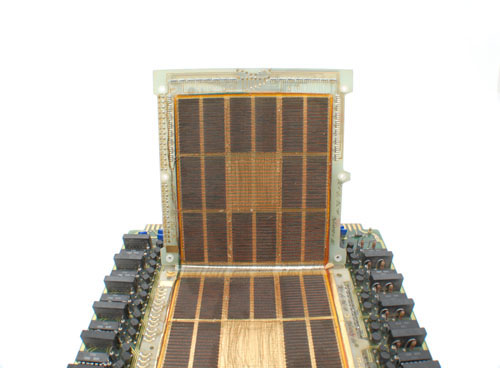

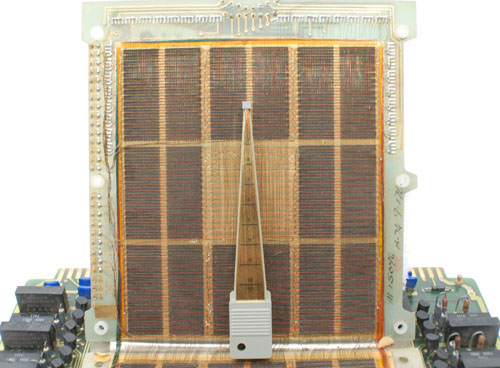
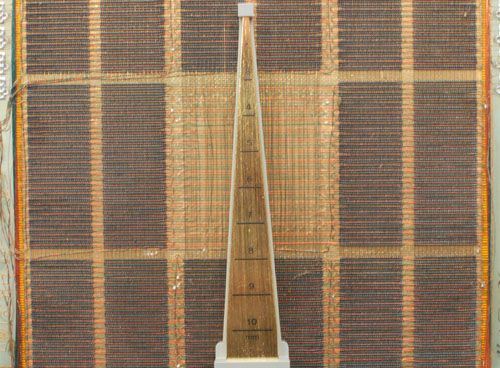
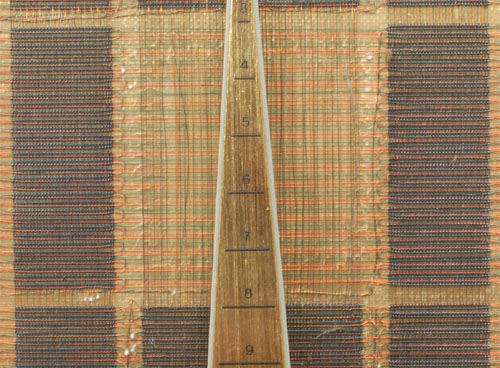
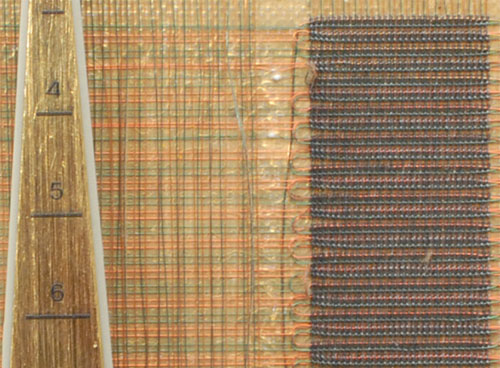

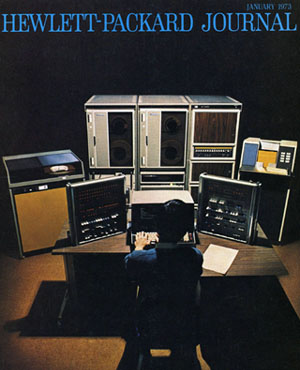 |
Cover of the Hewlett Packard Journal, January, 1973 Fully dedicated to the introduction of the HP 3000 Computer Courtesy of Hewlett Packard Company |
The first HP 3000 computer was produced at the end of 1972. The first two 1973 issues of the Hewlett Packard Journal were entirely dedicated to this important introduction.
The article "A Computer for All Reasons" reproduced below from the January 1973 Hewlett Packard Journal is another sign of the extreme care taken by HP to announce their entry into the "Multipurpose" Computer business.
Far from being an immediate success, the first units were withdrawn from the market, which was the first, and one of the major setbacks for the company's reputation. The original 3000 had 128 Kb of user memory (into which the MPE operating system could not even fit). The original machine could never support more than a handful of the 32 to 64 users originally promised.
This very difficult start didn't prevent the HP 3000 minicomputer from eventually becoming a very reliable and powerful business system. Today, after more than 30 years of evolution, the now-named E3000 series servers are still under support from many third party firms. By the end of 2006 there was no further support for the HP 3000 from the vendor.
For an in-depth understanding of the HP 3000 history, Bob Green's web site is a must:
A Computer for All Reasons |
|
Education and Instrumentation are traditional fields for HP,
and the HP 3000 Computer System significantly enhances
the company's capabilities in these areas. The new system is also well suited to advanced industrial and commercial applications. |
INSTRUMENTATION
|
From the Hewlett Packard Journal, January, 1973 - Courtesy of Hewlett Packard Company |
|
If the speed of progress was relatively slow at the beginning, the cause was, a certain amount of mistrust from at least one of the founders. They took extreme care because they were entering a domain where they were not sure of becoming immediate market leaders, as they had, in almost all their previous attempts. The market needs would quickly turn from hesitation at the start, to frenzy over the new development. Once more, and this time well above any other, the customer requirements would accelerate the speed of change . The main reasons are numerous but easy to understand today. Apart from IBM, who was the absolute leader in Business Computers in the early 70s, the other competitors were computer manufacturers. Most of them built good computer, but their skills were limited to building mainly computers . They were not multi-purpose electronic designers ... HP was! And the quantity of electronic hardware, still remaining to be invented for computers in 1970 was such that it would soon became the largest electronic playground wide open to Hewlett Packard 's craving for innovation. And this would eventually lead HP to become the World largest provider of computer peripheral of every kind. If only one of these products could be quoted as an example, then everybody knows what the printing technology evolution was in the beginning, and what Inkjet printing means to HP's business in the 21st century.
After the first two or three years of the seventies, cataloging and listing the new products related to computers and associated peripherals would be an almost impossible challenge. We would have great trouble fitting it into this "Quick Tour" chapter. So to help ourselves and to give you a better insight we have built the table below. The main purpose is to gather together some of the most significant products which were year after year the most important milestones of the Hewlett Packard Computer history.
We hope this timeline slide rule will be of some interest to other HP computer history enthusiasts. This table will be completed with other product lines e.g. terminals and plotter/printer. And obviously it will be enlarged to cover the next twenty years of the 1980-2000 timeline to come.

|

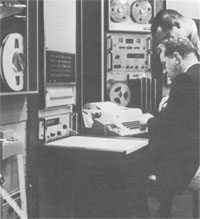 |
Another interesting analysis of the first ten years of HP computer production was made in the October 1976 issue of MEASURE Magazine
4 pages from the October 1976 MEASURE Magazine
The link above gives access to this article reproduction.
Finally by the end of the 70s, for the first time HP marketing campaign clearly, but carefully, claimed that they were targetting the Business Computer Market.
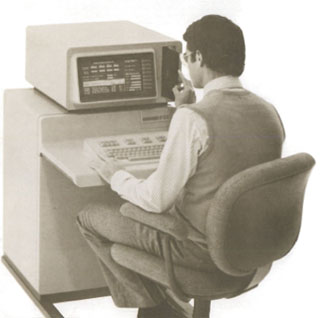 |
The HP 300 Computer - Photo from MEASURE Magazine, October 1978 Courtesy of the Hewlett Packard Company |
HP introduced the HP 300 computer in the June 1979 issue of the Hewlett Packard Journal. The HP 300 is an advanced, office-oriented multi-user system designed to simplify the tasks of developing and running business application programs.
The HP 300 marks the beginning of a major new computer family intended for business data processing applications.
For the first time, Ed McCracken, general manager of General Systems Division, discusses HP's growing commitment to the business-computer business in the October 1978 issue of the MEASURE Magazine. But nethertheless he carefully explains the way followed to finally arrive at that result. The article is partially reproduced below.
"What is HP doing in the business computer market ? The answer is, pretty much the same thing HP has been doing for years in other areas-offering electronic tools, based on our own
experience of their usefulness, that help other organizations get their jobs done faster, better, and at less cost. At first, we at HP built tools for electronic engineers, but over time we have
expanded the range of people for whom we build tools. We've added doctors, nurses, chemists, chemical engineers and materials scientists. Now we are serving business decision makers as
well.
Successful growth at HP has usually been in one of two ways. Either we offer new and improved products to markets where we already are well known, or we offer well-proved existing
products to markets that are new to us. Rarely is it possible to move both ways at once, simultaneously developing new products and building an organization to market them where we never
had such an organization before. Our entry into the business-computer business was typical. When the HP 3000 was invented more than five years ago, it was far ahead of its time. Here was a
computer with characteristics that were then typical only of million-dollar machines, yet its price was less than a quarter of that figure. We aimed it at the scientific computer market where we
had a marketing activity already in place. We tended to sell mostly to forward-looking customers who had, themselves, great expertise in applying computers. It was some years later, with a
well-proven HP 3000, that we entered the business-computer market in a substantial way. For some time, the HP 3000 was our sole entry in that market.
Our own best customer...
Fortunately, HP was itself one of those early, expert customers, and many 3000s were put to work to bring to divisions and departments of our company new, problem-solving computer resources of a kind that once were available only to top management. Today we have 66 systems in use throughout the company oriented toward business applications. We have based our approach to outside customers on the experience we have gained within HP.
The cost of information-managing machinery-for that is what computers really are-has been coming down about 30 percent every year for a long while now, and it appears that it will continue to come down at that rate, or better, for a long time to come. At the same time, the cost of almost anything else one can name, including that of the experts who run these machines, has been going up.
The consequences, for us and for the management of all organizations, large and small, are important and far-reaching. By distributing new, low-cost computer resources out among the locations where the work is done and the information originates, an organization now can give local management the ability to control its activities locally, and thus to assume a fuller measure of responsibility for them. Decisions can be made locally because management decision makers can now afford the business decision-making tools to analyze alternates.
Work is accomplished more effectively, and is more meaningful to those who perform it."
...A Desktop & Pocket Calculators chapter for the 1960-1980 period is under construction... And the story will be continued in various dedicated Chapters for the 1980-2000 period.